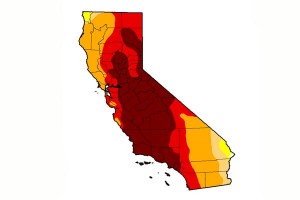City plans for state-mandated water usage cuts

Drought conditions as of March 31, 2015, with the dark red areas indicating areas of “extreme drought.”
On April 1, 2015, Governor Brown issued an executive order calling for further mandatory reductions in urban water use. At Tuesday night’s Paso Robles City Council meeting, newly appointed Public Works Director Dick McKinley gave a report that suggested ways the city could comply. The council approved the resolution in a 4-1 vote.
The state-wide reductions are based on percentage of gallons of water used per person per day, as some areas use more water than others; for Paso Robles, the required cut is 28 percent total.
The city has already done a fairly good job at reducing water use, McKinley said, and is on track to continue water conservation efforts recently put in place. To achieve the required cuts, the city must reduce usage by an additional 19% from last year’s levels. This equates to an average of 1.4 million gallons less per day in the summer months, and 0.5 million gallons daily in the winter months. The critical period of usage is June 2015 thru February 2016.
While “Level 2” watering restrictions have been in effect since February 2012, including a 3 day/week landscape watering schedule and other use prohibitions, additional measures are needed to achieve the mandated reductions, McKinley said.
Noncompliance would equate to $10,000 per day for the city. Individuals will face fines for excessive water use.
The fine structure was based on the calculation that, 78 percent of all residences use 25 units of water or less per month, with one unit equaling one hundred cubic feet, or HFC, or 8,730 gallons. The fine for going over the 25 units per month, but less than 50 would be 10 dollars per unit, and use over 50 units would incur a fee of 20 dollars per unit.
Local resident Braun Berry asked, “What is the situation with our water?” saying that he believed that the city had, “plenty of water.” McKinley replied that the city has “adequate” water for right now, but pointed out that the state as a whole is in a state of severe drought, experienced virtually no snow-pac on the Sierra Nevada, and locally, our aquifer is dropping, and our lakes are at critically low levels.
Local resident Nann Moss asked whether of not the wineries would be affected by the cuts. McKinley said that there would be no impact on the wineries, as this state mandate does not address agriculture.
In Paso Robles, the per capita gallons per day used is about 146. In San Luis Obispo the gallons per day is about 69.”One hundred and forty fix is not bad for a city like Paso Robles. We can always get better,” said McKinley.
McKinley suggested that the city:
a) Cease irrigation of street median and parkway turf
b) Cease watering ornamental turf at other City facilities such as City Hall, Public Safety Center, etc.
c) Erect signage alerting the public to the reason for watering restrictions
d) Cease irrigation within landscape and lighting districts as above
These above measures would be in compliance with the state mandate.
Overall, the plan to reach the required level of cuts would include: encouraging turf replacement, adding to the budget for rebate programs, shifting to a 2 day per week watering schedule, imposing excessive use penalties, hiring one additional seasonal water conservation staff, and programming a billing system to assess penalties.
These cuts are focused primarily on landscaping, not business, McKinley said.
Anticipated reduced water sales resulting from the 2-day watering schedule are expected to reduce revenue to the Water Fund No. 600 by as much as an estimated $1.1 million per year. Resulting operating deficits will be covered by retained earnings (a.k.a., reserves), McKinley stated in his report.
Addressing ornamental landscape areas like medians, Councilman Jim Reed asked, “Will they become an eye-sore?” City Manager Jim App said that currently, the focus is on meeting the state order, but in the future, the city will look at replanting ornamental areas with drought-tolerant plants. The order to cease watering ornamental turf, would exclude trees and shrubs.
Councilman Fred Strong suggested that the council adopt the new reduction recommendations, with the exception of including parkways, which were not specifically mandated by the executive order. The council decided to adopt the recommendations with the exception of parkways on a 4-1 vote, with Councilman Reed dissenting. Reed said that he felt that the recommendations, “needed work,” and citing issues with the plan to hire additional conservation staff.





















